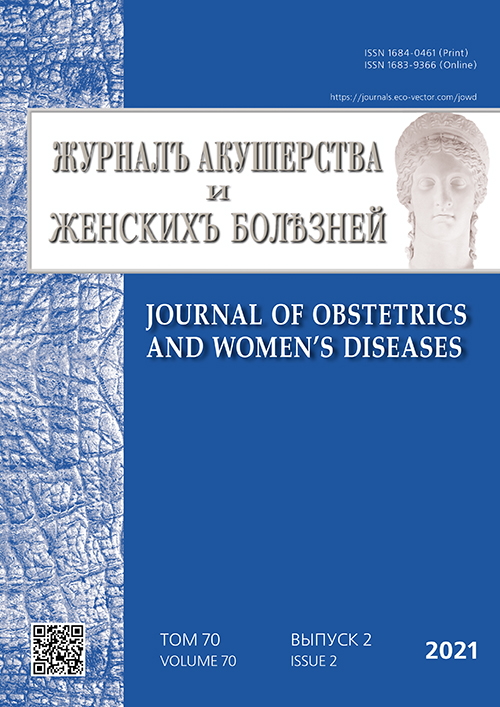Randomized comparative study of the effectiveness and safety of various bipolar devices during electrosurgical vaginal hysterectomy
- 作者: Plekhanov A.N.1,2, Bezhenar V.F.1, Epifanova T.A.1,2, Bezhenar F.V.2, Karabak I.A.3
-
隶属关系:
- Academician I.P. Pavlov First St. Petersburg State Medical University
- Saint Petersburg Clinical Hospital of the Russian Academy of Sciences
- Pediatric Research and Clinical Center for Infectious Diseases
- 期: 卷 70, 编号 2 (2021)
- 页面: 45-54
- 栏目: Original study articles
- URL: https://ogarev-online.ru/jowd/article/view/71084
- DOI: https://doi.org/10.17816/JOWD71084
- ID: 71084
如何引用文章
详细
AIM: The aim of this study was to investigate the morphometric features of tissues after exposure to bipolar energy of various electrosurgical generators and surgical hemostatic instruments used in vaginal hysterectomy.
MATERIALS AND METHODS: The study included 48 individuals who underwent a vaginal hysterectomy. The patients were divided in three groups based on the instrument used for sealing blood vessels: a BiClamp® was applied in Group 1 (n = 16), a TissueSeal PLUS COMFORT® in Group 2 (n = 16), and a Thunderbeat® in Group 3 (n = 16). The maximum temperature of tissue measured using a Fluke FLK TIS 40 9HZ thermal imaging infrared camera was compared within the groups.
RESULTS: The maximum tissue temperature between the branches on electroligation, the minimum tissue temperature, and the tissue temperature at the coagulation boundary were significantly lower when using a TissueSeal PLUS COMFORT® clamp than when using BiClamp® and Thunderbeat® clamps (H value = 41.8, p ≤ 0.01). Morphometric parameters (prevalence, coagulation depth and area) were the smallest with a TissueSeal PLUS COMFORT® clamp compared to other clamps.
CONCLUSIONS: Using a TissueSeal PLUS COMFORT® clamp during vaginal hysterectomy is effective and safe and has the best thermometric and morphometric characteristics when applied to the tissue, thereby reducing the risk of lateral thermal damage. The possibility of perifocal heat transfer varies with the type of tool and with the temperature at the coagulation boundary.
作者简介
Andrey Plekhanov
Academician I.P. Pavlov First St. Petersburg State Medical University; Saint Petersburg Clinical Hospital of the Russian Academy of Sciences
编辑信件的主要联系方式.
Email: a_plekhanov@mail.ru
ORCID iD: 0000-0002-5876-6119
SPIN 代码: 1132-4360
Scopus 作者 ID: 842119
MD, PhD, DSci (Medicine)
俄罗斯联邦, 6-8 L’va Tolstogo str., Saint Petersburg, 197022; Saint PetersburgVitaliy Bezhenar
Academician I.P. Pavlov First St. Petersburg State Medical University
Email: bez-vitaly@yandex.ru
ORCID iD: 0000-0002-7807-4929
SPIN 代码: 8626-7555
Scopus 作者 ID: 271233
MD, PhD, DSci (Medicine), Professor
俄罗斯联邦, 6-8 L’va Tolstogo str., Saint Petersburg, 197022Tatyana Epifanova
Academician I.P. Pavlov First St. Petersburg State Medical University; Saint Petersburg Clinical Hospital of the Russian Academy of Sciences
Email: epifanova-tatiana@mail.ru
ORCID iD: 0000-0003-1572-1719
SPIN 代码: 5106-9715
MD, Post-Graduate Student
俄罗斯联邦, 6-8 L’va Tolstogo str., Saint Petersburg, 197022; Saint PetersburgFyodor Bezhenar
Saint Petersburg Clinical Hospital of the Russian Academy of Sciences
Email: fbezhenar@gmail.com
ORCID iD: 0000-0001-5515-8321
SPIN 代码: 6074-5051
MD
俄罗斯联邦, Saint PetersburgIrina Karabak
Pediatric Research and Clinical Center for Infectious Diseases
Email: irina-karabak@mail.ru
ORCID iD: 0000-0002-3725-7737
SPIN 代码: 1905-7431
MD
俄罗斯联邦, Saint Petersburg参考
- Ailamazyan EK, Bezhenar VF, Savitsky GA, et al. The rational choice of surgical approach for hysterectomy. J Gynecol Surg. 2006;(3 suppl. 1):S95–S96.
- Bezhenar’ VF, Novikov EI, Vasilenko LV, Komlichenko JeV. Vlagalishhnye operacii. Saint-Petersburg: Izd-vo N-L; 2013. (In Russ.)
- Whiteman MK, Hillis SD, Jamieson DJ, et al. Inpatient hysterectomy surveillance in the United States, 2000-2004. Am J Obstet Gynecol. 2008;198(1):34.e1–34.e347. doi: 10.1016/j.ajog.2007.05.039
- Candiani M, Izzo S, Bulfoni A, Riparini J, Ronzoni S, Marconi A. Laparoscopic vs vaginal hysterectomy for benign pathology. Am J Obstet Gynecol. 2009;200(4):368.e1–368.e3687. doi: 10.1016/j.ajog.2008.09.016
- Forsgren C, Altman D. Risk of pelvic organ fistula in patients undergoing hysterectomy. Curr Opin Obstet Gynecol. 2010;22(5):404–407. doi: 10.1097/GCO.0b013e32833e49b0
- Moen MD, Richter HE. Vaginal hysterectomy: past, present, and future. Int Urogynecol J. 2014;25(9):1161–1165. doi: 10.1007/s00192-014-2459-x
- Plekhanov AN, Bezhenar VF, Epifanova TA, et al. Tissue thermometric characteristics in the intervention area during electrosurgical vaginal hysterectomy. Obstetrics and Gynecology. 2020;(6):98–105. (In Russ.). doi: 10.18565/aig.2020.5.98-104
- Pogorelić Z, Katić J, Mrklić I, et al. Lateral thermal damage of mesoappendix and appendiceal base during laparoscopic appendectomy in children: comparison of the harmonic scalpel (Ultracision), bipolar coagulation (LigaSure), and thermal fusion technology (MiSeal). J Surg Res. 2017;212:101–107. doi: 10.1016/j.jss.2017.01.014
- Jaiswal A, Huang KG. Energy devices in gynecological laparoscopy — Archaic to modern era. Gynecol Minim Invasive Ther. 2017;6(4):147–151. doi: 10.1016/j.gmit.2017.08.002
- Zhu Q, Ruan J, Zhang L, Jiang W, Liu H, Shi G. The study of laparoscopic electrosurgical instruments on thermal effect of uterine tissues. Arch Gynecol Obstet. 2012;285(6):1637–1641. doi: 10.1007/s00404-011-2207-0
补充文件
















